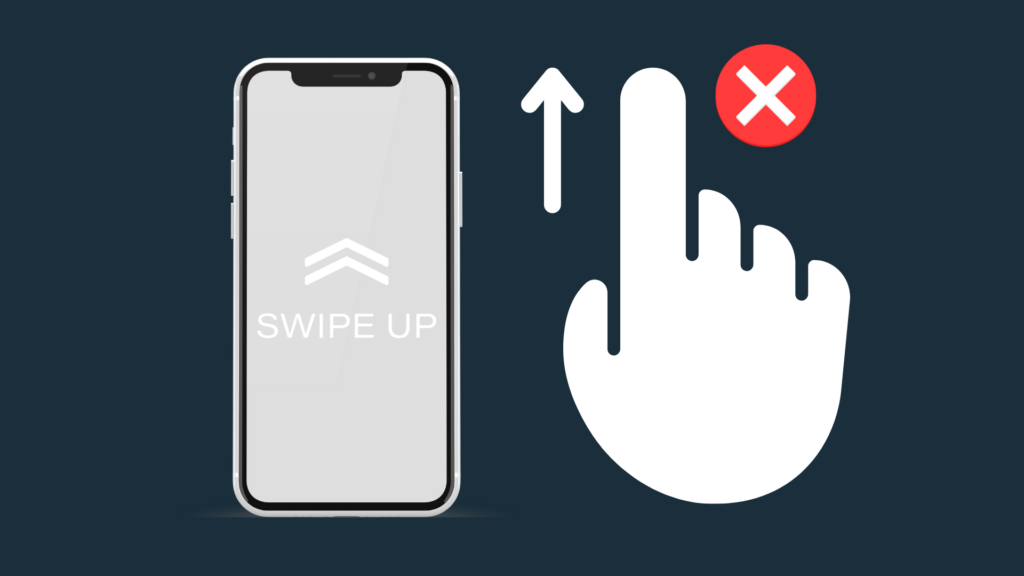iPhone won’t Swipe Up: Fix it in Seconds

Ever since the advent of touch controls on phones, using cell phones has become a much easier task. There are pros and cons to using a touchscreen and using a keyboard, but for most people, a touchscreen wins 99 percent of the time. The iPhone is one such example of a phone with a touchscreen, and you can use it to do various movements, such as tapping and swiping. But why might an iPhone not be swiping up? And how can that be fixed?
If your iPhone doesn’t swipe up, it is either due to hardware or software issues. A hardware issue that could be preventing this from working is an extremely uncalibrated touchscreen, or a touchscreen that is altogether broken. There could also be an issue with the software, or operating system specifically, that is causing the swipe to be delayed.
But what can you do to make the iPhone swipe function work again? And if you can’t fix it, is there any way to replace your iPhone?
iPhone won’t Swipe Up (How to Fix It)
The method to fix your iPhone not being able to swipe up will depend on what is causing it to happen. If it is a hardware issue, fixing the problem could be a lot more complicated, unfortunately.
Enable Control Center on the lock screen
Not having Control Center enabled on the lock screen could prevent your ability to swipe up on the iPhone’s screen. To enable it, go to the Settings app, tap ‘Control Center’, and finally, toggle ‘Access to Lock Screen’ to ‘ON’.
Disable Control Center options that are creating issues
If the above method does not work, there may be an issue with one of the Control Center items. To fix this, you should reset the settings of your items to their original settings. To do this, go to the Settings app, select ‘Control Center’, and navigate to the ‘Include’ section. You will see a list of controls, so enable or disable them as needed if they are causing you any grief.
Enable Control Center access in apps
To get the Control Center to work in certain apps, you need to give it permission. Go into Settings, then tap ‘Control Center’, where you will then tap the option ‘Access Within Apps’ to enable this.
Make sure nothing on your iPhone is broken
One issue that could be causing this is if the iPhone is broken. Some breaks could be more obvious than others, with some being easier to prescribe a solution as a result. For instance, if you have a crack on your screen, this may indicate that whatever cracked your screen also reduced the touchscreen’s effectiveness. However, if there is no perceived damage, it may be more difficult to figure out if it is damaged at all. If your iPhone is unable to swipe up, it is likely that other touchscreen gestures may not be working either, such as swiping down. You may also be completely unable to use the touchscreen at all if it is broken.
Ensure that your iPhone’s case is not interfering with swiping up
While this is not typical, it is possible that the case you have on your iPhone is preventing the phone from swiping up. Some report issues swiping up at all, while others find it spotty or otherwise difficult. You may even find that the touchscreen is not working at all. To see if your case is giving you grief, take it off, and test the touchscreen without it. If things are working as they normally would, be sure to switch to a new case. If the case had been working until recently, you could just as well buy the same case. However, if the case is new and had the problem right out of the box, you should look for a different case with a large number of four- and five-star reviews.
Restart your iPhone
The iPhone only has so much memory it can use. Thus, if you have too many apps running all at once, you may find that the iPhone has performance issues, like crashing, freezing, or otherwise being very laggy. One thing this could cause with your iPhone is that swiping up on your iPhone is such a laggy gesture that it appears like it is not functioning at all. There are two ways you can fix this.
The first, and easiest, would be to simply restart your phone. To do this, hold the power and volume buttons on the side of the iPhone until a slider appears on-screen. You can trigger a force restart if this does not work by pressing Volume Up, Volume Down, and finally, Power. Different iPhones may have different methods of powering down and restarting, so if this does not work for you, look up the methods for your specific iPhone.
Calibrate the iPhone’s touchscreen
Another thing that could affect your iPhone’s ability to swipe up is if the touchscreen is improperly calibrated. Over time, a touchscreen may lose precision with its touchscreen. To calibrate the touchscreen, even if after calibration the touchscreen is off, you may need to restart the iPhone altogether. It should be noted, however, that if you cannot swipe on your iPhone at all, it is probably due to the touchscreen not working properly instead of being poorly calibrated, as you should have some ability to swipe, even if it is inaccurate.
Update the iPhone’s firmware
A software or firmware issue could be what is responsible for the touchscreen not swiping. This often manifests in the touchscreen inputs being so laggy that the swiping function does not respond immediately. If this is the case, check to see whether you are updated to the latest iPhone version, which may fix the issue. Much like with calibration issues, however, this may not fix the problem, and may require you to do a factory reset instead.
Reset your iPhone’s settings
This step is not exactly the ideal one to have to take, but if nothing else seems to be working, it may be your best bet. If you’re ready to take this step, go to your Settings app, and select ‘General’. Find the ‘Transfer or Reset iPhone’ option, and select it. Tap ‘Reset’, and then tap ‘Reset All Settings. If you are prompted to enter your passcode, enter it, and then tap on ‘Reset All Settings’ again to confirm the changes. Your device will restart, and if it works, you should be able to swipe up again.
Restore the iPhone to factory settings
This step is a drastic one, and should only be tried as a last resort, but if none of the above steps seem to fix the issue, this could be the best way to get your iPhone working normally again. Taking this step means that everything about your phone will be erased. Not just your sign-in information, downloaded apps, contact information, etc., but also your call log, photos, videos, and more will be lost.
Essentially, your iPhone will only have as much as it did when you originally bought it. Because of this, you should make sure that you upload any important files to your computer or cloud service. After all, the last thing a lot of people want to have happen is lose irreplaceable photos and videos.
To restore your iPhone to factory settings, go to ‘Settings’ on your iPhone, and then ‘General’. In this section, you will see the ‘Transfer or Reset’ option, and then select ‘Erase All Content and Settings’. You may be asked to enter either your passcode or Apple ID password. Once you have done this, confirm that you want to do this, and then wait for the process to be completed (usually around a few minutes).
After this, you will be able to set it up with your Apple ID and more. If something on your phone was affecting the quality of the swiping, your phone should now not have any issue with it anymore. If it still does, your last resort would be to contact Apple, who may be able to help figure out the specifics of your issues, and hopefully, eliminate the issue altogether.
How to transfer files from an iPhone
There are two ways to transfer files from your iPhone before you reset your device. The first is to connect your iPhone to another device via a USB or Lightning cable to initiate the transfer. Both the iPhone and the computer need to be powered on in order for the transfer to occur. If you are doing it via a Windows PC, go to Windows Explorer. From here, you will see an iPhone icon listed under Portable Devices. Double click on the icon, and go to Internal Storage, where you will see the files on the iPhone. To access your photos and screenshots, open the DCIM folder. Finally, copy and paste them onto your computer.
If you are trying to transfer the files to a Mac computer, connect the two devices the same way you do on a Windows computer. Go to your Mac computer, and go to the Finder sidebar, where you will see your iPhone. Select it, and at the top of the Finder window, select ‘Transfer from iPhone to Mac’. Another method that can be used to transfer files is called Wi-Fi syncing. To set this up, select your iPhone in the same way as you did above, making sure that the devices are connected via a cord. Click at the top of the window, and select ‘Show this iPhone when on Wi-Fi.’ If you want to transfer with Finder, you need to make sure that your Mac computer is macOS version 10.15 or higher.
What do I do if I can’t make my iPhone swipe up?
If your iPhone is unable to swipe up even after you have taken all of the above-mentioned steps, this may mean that the device is in need of repairs or a replacement. How costly a repair or replacement will be will ultimately come down to the circumstances of the damage. A new iPhone comes with a warranty that covers defects, so if, for instance, a defect causes the swipe function to not work properly, you would be able to get a replacement iPhone at no additional cost. However, if the damage was your responsibility, or if the damage occurred outside of the warranty period, you may not be able to get a repair or replacement. However, you can get an extended warranty that covers more than just manufacturer defects, as well as covers a longer span of time (which is one year).
Before you send it in for repairs or replacement, though, you may want to contact Apple customer service to make sure they cannot help you figure out what is going wrong with your touchscreen. They may be able to understand what is going on with your iPhone, ensuring that you can get the problem fixed more quickly and with less frustration.





